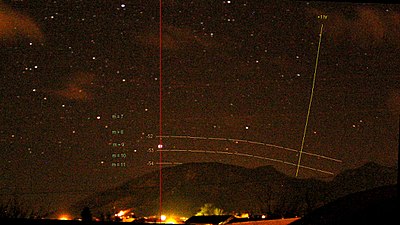 Hereford Arizona Observatory (HAO) HAO#1 and HAO#2. | |
| Organization | |
|---|---|
| Observatory code | G95 |
| Location | Arizona |
| Coordinates | 31°27′08″N 110°14′16″W / 31.4522°N 110.2378°W / 31.4522; -110.2378 |
| Altitude | 4,670 ft (1,420 m) |
| Website | www |
| Commercial telescopes |
|
| | |
Hereford Arizona Observatory (HAO), IAU-code G95, is an astronomical observatory, owned and operated by amateur astronomer Bruce L. Gary. Observational studies of unusual starlight fluctuations in Tabby's Star (KIC 8462852) and WD 1145+017 are recent interests.
HAO consists of two telescopes, in two separate observatory installations: HAO#1 (contains a Celestron CPC 1100, 11-inch Schmidt-Cassegrain telescope on an equatorial mount) and HAO#2 (contains an Astro-Tech Ritchey–Chrétien, 16-inch telescope on an equatorial mount).
The observatory is located in Arizona about 130 km (80 mi) southeast of Tucson and about 11 km (7 mi) north of the Mexican border. Coordinates are at the following: North Latitude +31:27:08 and West Longitude 110:14:16, at an altitude of 1,423 m (4,670 ft).

Gallery
-
HAO control room − the Celestron-11 telescope is managed by a dedicated computer on the left; the Meade-14 by one on the right.
See also
- List of astronomical observatories
- List of observatory codes
- Tabby's Star (KIC 8462852) − oddly dimming star
- WD 1145+017 - star destroying planetesimal, producing a dusty disk
References
- ^ Gary, Bruce L. (17 May 2017). "Hereford Arizona Observatory (HAO)". BruceGary.net. Retrieved 22 September 2017.
- Staff (2017). "List Of Observatory Codes". Minor Planet Center. Retrieved 22 September 2017.
- Gary, Bruce L. (12 August 2017). "Bruce L. Gary - Resume". BruceGary.net. Retrieved 22 September 2017.
- Gary, Bruce L. (16 September 2017). "Hereford Arizona Observatory photometry observations of KIC 8462852 between 2 May and 16 September 2017". BruceGary.net. Archived from the original on 17 September 2017. Retrieved 17 September 2017.
- Rappaport, S.; Gary, B.L.; Vanderburg, A.; Xu, S.; Pooley, D.; Mukai, K. (2018). "WD 1145+017: Optical Activity During 2016-2017 and Limits on the X-Ray Flux". Monthly Notices of the Royal Astronomical Society. 474 (1): 933–946. arXiv:1709.08195. Bibcode:2018MNRAS.474..933R. doi:10.1093/mnras/stx2663.
External links
- Official HAO WebSite
- Bruce L. Gary WebSites
- Bruce L. Gary (GoogleScholar)
- Amateur Exoplanet Archive (AXA)
- Hereford Arizona Observatory (NatureIndex)
- NASA Asteroid and Comet Watch Site
- Near Earth Asteroid Tracking (NEAT)
| Main | |||||||||
|---|---|---|---|---|---|---|---|---|---|
| Distribution |
| ||||||||
| Classification |
| ||||||||
| Exploration | |||||||||
| Lists | |||||||||
| Related | |||||||||
| |||||||||||||||||||||
Solar System → Local Interstellar Cloud → Local Bubble → Gould Belt → Orion Arm → Milky Way → Milky Way subgroup → Local Group → Local Sheet → Virgo Supercluster → Laniakea Supercluster → Local Hole → Observable universe → Universe | |||||||||||||||||||||
Exoplanets | |||||||
|---|---|---|---|---|---|---|---|
| Main topics | |||||||
| Sizes and types |
| ||||||
| Formation and evolution |
| ||||||
| Systems | |||||||
| Host stars | |||||||
| Detection | |||||||
| Habitability |
| ||||||
| Catalogues | |||||||
| Lists |
| ||||||
| Other |
| ||||||
| Molecules |
| |||||||||||||||||||
|---|---|---|---|---|---|---|---|---|---|---|---|---|---|---|---|---|---|---|---|---|
| Deuterated molecules | ||||||||||||||||||||
| Unconfirmed | ||||||||||||||||||||
| Related |
| |||||||||||||||||||








